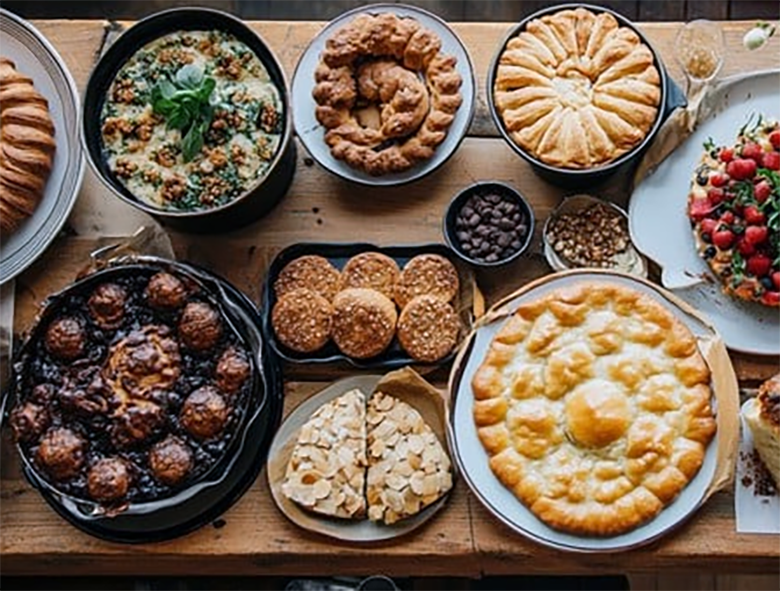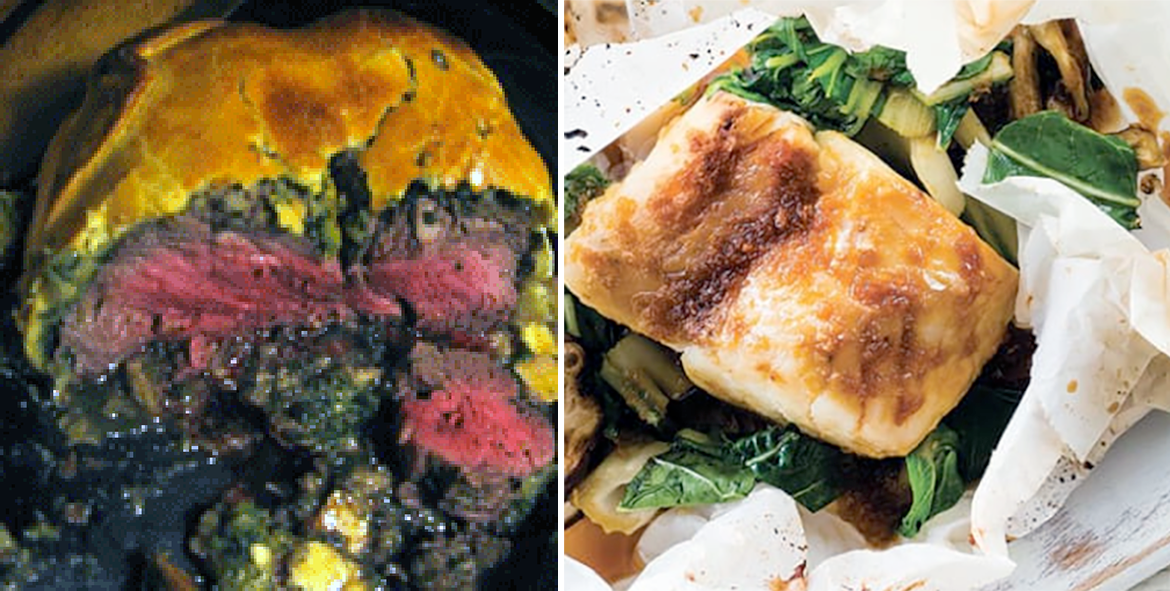FabulousFusionFood's Baking Recipes 7th Page
 A range of baked goods.
A range of baked goods.
Welcome to FabulousFusionFood's Baking Recipes Page — This is a continuation of an entire series of pages that will, I hope, allow my visitors to better navigate this site. As well as displaying recipes by name, country and region of origin I am now planning a whole series of pages where recipes can be located by meal type and main ingredient. This page gives a listing of all the baking recipes added to this site. Baking is defined as a technique for the prolonged cooking of food using dry heat by the action of conduction. Baking is normally done in an oven, but goods may also be baked in hot ashes or on hot stones. Baking differs from Roasting Recipes in that a lower temperature is typically used and the items are cooked for a longer period of time. Baking is a much older process than most people think and foods were probably originally baked in embers or with hot stones (which is how bread may have started). Only later did specialist ovens develop. Though most baked goods tend to be bread or cake-based some other dishes such as pasta dishes and vegetable dishes may also be baked. Stews are often also technically baked in an oven, but are not classed as 'baked goods' in that they are more liquid than solid at the end of the cooking process.
Baking is a method of preparing food that uses dry heat, typically in an oven, but can also be done in hot ashes, or on hot stones. The most common baked item is bread, but many other types of foods can be baked. Heat is gradually transferred "from the surface of cakes, biscuits and cookies, and pieces of bread to their centre, typically conducted at elevated temperatures surpassing 150°C. Dry heat cooking imparts a distinctive richness to foods through the processes of caramelization and surface browning. As heat travels through, it transforms batters and doughs into baked goods and more with a firm dry crust and a softer centre. Baking can be combined with grilling to produce a hybrid barbecue variant by using both methods simultaneously, or one after the other. Baking is related to barbecuing because the concept of the masonry oven is similar to that of a smoke pit.
In addition to bread, baking is used to prepare cakes, pastries, pies, tarts, quiches, biscuits and cookies, scones, crackers, pretzels, and more. These popular items are known collectively as 'baked goods', and are often sold at a bakery, which is a store that carries only baked goods, or at markets, grocery stores, farmers markets or through other venues.
 Beef en croûte (left) and fish en papillote (right).
Beef en croûte (left) and fish en papillote (right).
The alphabetical list of all the baking recipes on this site follows, (limited to 100 recipes per page). There are 2282 recipes in total:
Page 7 of 23
| Cornish Clotted Cream Rice Pudding Origin: England | Cottage Pie Origin: Britain | Crockpot Chocolate and Amaretto Cheesecake Origin: America |
| Cornish Cream Tea Scone Origin: England | County Cavan Soda Bread Origin: Ireland | Croissants Origin: France |
| Cornish Cutting Pie Origin: England | Course Ginger Bread Origin: Britain | Croquets of Meat or Fish Origin: British |
| Cornish Easter Cakes Origin: England | Cozonac (Romanian Sweet Bread) Origin: Romania | Crostata di Marmellata (Italian Jam Tart) Origin: Italy |
| Cornish Fairings Origin: England | Crème Brûlée au Mélilot (White Clover Crème Brûlée) Origin: France | Crostata di Marmellata (Italian Jam Tart) Origin: Italy |
| Cornish Farmhouse Cake Origin: Britain | Crème Brulée Origin: France | Crostata di Ricotta (Ricotta Tart) Origin: Italy |
| Cornish Farmhouse Sultana Cake Origin: England | Crab and Watercress Quiche Origin: Britain | Crumpets Origin: Britain |
| Cornish Fish Pie Origin: England | Crab Cakes Origin: Fusion | Crunchy N'Dizi (Crunchy Bananas) Origin: Kenya |
| Cornish Fruit Loaf Origin: England | Crabe Béninoise (Beninese Crabs) Origin: Benin | Crustardes of Flessh Origin: England |
| Cornish Gingerbreads Origin: England | Cranachan flapjacks Origin: Scotland | Crustless Pumpkin Pie Origin: American |
| Cornish Great Cake Origin: England | Cranberry and Orange Cheesecake Origin: Britain | Crymbl Mwyar Duon (Welsh Blackberry Crumble) Origin: Welsh |
| Cornish King Scallops and Black Pudding Origin: Canada | Cranberry and White Chocolate Cheesecake Origin: American | Cuciadate (Italian Fig Rolls) Origin: Italy |
| Cornish Luncheon Cake Origin: England | Cranberry Eggnog Muffins (Cranberry Eggnog Muffins) Origin: American | Cumin Potatoes with Peas Origin: Ireland |
| Cornish Miner's Bread Origin: Britain | Cranberry Lime Cheesecake Origin: Britain | Curd Cake Origin: Britain |
| Cornish Oatmeal Scones Origin: England | Cranberry Orange Quickbread Origin: American | Curly Dock Seed Crackers Origin: American |
| Cornish Pasty Pie Origin: England | Cream Cheese Filled Cupcakes Origin: American | Curly Dock Seed Flour Origin: Britain |
| Cornish Porter Cake Origin: England | Cream Sponge Cake Origin: American | Curly Dock Seed Flour Biscuits (Curly Dock Seed Flour Flour Biscuits) Origin: Britain |
| Cornish Railway Pudding Origin: England | Cream-less Quiche Origin: Fusion | Currant Scones Origin: Britain |
| Cornish Rock Cakes Origin: England | Creamed Cottage Cheesecake Origin: American | Currant Shortbread Origin: Scotland |
| Cornish Saffron Buns Origin: England | Creamed Ground Elder Origin: Britain | Curranty 'Obbin Origin: England |
| Cornish Saffron Cake Origin: England | Creamy Chilled Cheesecake Origin: American | Curranty Bread Origin: Britain |
| Cornish Seedy Bread Origin: Britain | Creamy Lemon Glaze Origin: American | Curried Beef Gratin Origin: African Fusion |
| Cornish Seedy Cake Origin: Britain | Creamy Monkfish and Shellfish Potpie Origin: British | Curried Gluten-free Lamb Cobbler Origin: Britain |
| Cornish Splits Origin: England | Creamy Orange Crockpot Cheesecake Origin: American | Curry and Cardamom Cookies Origin: American |
| Cornish Squab Pie Origin: Britain | Creamy Potato and Vegetable Pie Origin: Ireland | Custard-baked Sago Pudding with Meringue Topping Origin: South Africa |
| Cornish Store Cake Origin: England | Creamy Potato Gratin Origin: Britain | Cypriot Pitta Bread (Envelope Bread) Origin: Cyprus |
| Cornish Tea Biscuits Origin: England | Crema Catalana (Catalan Caramel Cream) Origin: Spain | Cyw Iâr Halen (Salted Chicken) Origin: Welsh (Patagonia) |
| Cornish Tea Treat Buns Origin: England | Crema de Frutas con Barquillo (Fruit and Cream with Wafers) Origin: Spain | Cyw Iâr Pen Llŷn (Llŷn Peninsula Chicken) Origin: Welsh |
| Cornish Tea-cakes Origin: England | Crème Brûlée Cheesecake Origin: South Africa | Dabo Origin: Ethiopia |
| Cornish Under-roast Origin: England | Cremes caramel au beurre sale (Breton salted butter caramel cake) Origin: France | Dabo Kolo (Crunchy Spice Bites) Origin: Ethiopia |
| Cornish Wine Cake Origin: England | Crempog Gri (Welsh Currant Pancake) Origin: Welsh | Dacquoise Origin: France |
| Cornmeal Dough Pizza Base Origin: American | Criollo de los Mordedores (Snapper Criollo) Origin: Venezuela | Daisy Cupcakes, with a Secret Origin: Britain |
| Cornulete Vanilate (Romanian Walnut Crescents) Origin: Romania | Croatian Nut Meringue and Jam Biscuits Origin: Croatia | |
| Costmary Shortbread Origin: Britain | Crockpot Cherry Cobbler Origin: American |
Page 7 of 23